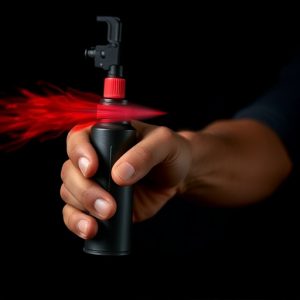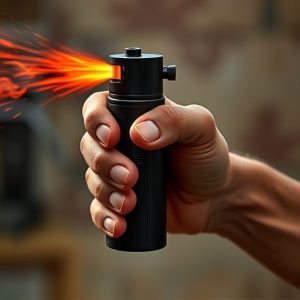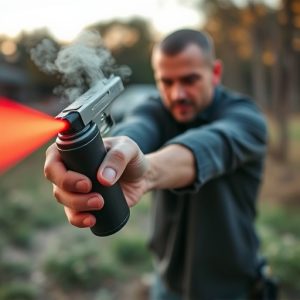Storing Pepper Spray: Safety & Effectiveness Guide for Optimal Performance
Storing pepper spray properly (cool, dry places, away from sunlight, sealed containers) is vital for…….
Storing pepper spray properly (cool, dry places, away from sunlight, sealed containers) is vital for preserving its effectiveness and potency. Avoid extreme temperatures & moisture as they degrade the active ingredient, capsaicin. Follow safety guidelines for storage, disposal, and keep out of reach to prevent misuse, ensuring pepper spray remains a reliable law enforcement tool.
In the realm of law enforcement, a strategic tool in their arsenal is police-grade inflammatory pepper spray. This potent compound, designed for maximum effectiveness, requires meticulous care during storage to ensure optimal performance. Understanding its composition and effects is crucial, alongside implementing proper safety precautions. This article delves into these aspects, offering insights on storing pepper spray effectively, debunking common misconceptions, and exploring legal considerations, ensuring responsible usage in today’s digital era.
- Understanding Pepper Spray Composition and its Effects
- Storage Conditions for Optimal Pepper Spray Performance
- Safety Precautions When Handling Police-Grade Pepper Spray
- Common Misconceptions About Storing Pepper Spray Debunked
- Legal Considerations and Regulations Surrounding Pepper Spray Possession
Understanding Pepper Spray Composition and its Effects
Pepper spray, a powerful law enforcement tool, is a compound designed to cause temporary yet intense discomfort, disorientation, and disability in targets. Its primary active ingredient is capsaicin, a chemical derived from chili peppers. This compound stimulates nerve endings, leading to a burning sensation, constricted breathing, and temporary blindness. Understanding the composition and effects of pepper spray is essential for its effective use and storage.
Proper storage plays a vital role in maintaining the maximum effectiveness of pepper spray. Exposing it to extreme temperatures or moisture can degrade the active ingredients, reducing its potency. Ideal storage conditions involve keeping it in a cool, dry place, away from direct sunlight. Ensuring the container remains sealed also helps maintain the chemical’s integrity. Additionally, storing pepper spray out of reach and following safety guidelines for disposal are crucial steps to prevent misuse and ensure its longevity as a law enforcement tool.
Storage Conditions for Optimal Pepper Spray Performance
Storing pepper spray properly is essential to maintain its maximum effectiveness. The ideal storage conditions vary slightly depending on the specific compound, but generally, it should be kept in a cool, dry place away from direct sunlight and extreme temperatures. Temperatures between 50°F and 70°F (10°C to 21°C) are considered optimal for most pepper spray formulations. Humidity levels should also be controlled, with ideal conditions around 40-50% relative humidity. Avoid storing pepper spray in areas prone to moisture build-up, such as basements or attics, where it could degrade over time.
Additionally, ensure the container is sealed tightly to protect against contamination and degradation. Keep the pepper spray out of reach of children and pets, and never store it near food or other items that could be accidentally exposed. Regularly checking the condition of the spray and its expiration date will help ensure its potency remains high. Sticking to these storage guidelines will contribute significantly to maintaining the performance and longevity of your pepper spray compound.
Safety Precautions When Handling Police-Grade Pepper Spray
When handling police-grade inflammatory pepper spray, safety precautions are paramount to prevent accidental exposure and maintain maximum effectiveness. Always wear protective gear, including gloves, eye protection, and a respirator, when using or storing the spray. Ensure the area is well-ventilated to avoid inhaling residual aerosol, which can cause serious respiratory issues. Store pepper spray in a secure, locked location, out of reach of children and unauthorized personnel. Keep it away from heat sources, direct sunlight, and moisture to maintain its potency.
Proper storage methods are crucial for preserving the spray’s efficacy. Use airtight containers designed specifically for pepper spray and labeled with the date of purchase and expiration. Store them in a cool, dry place, ideally at temperatures below 25°C (77°F). Regularly inspect the spray for any signs of damage or leakage. If the spray is left unused for an extended period, check its potency and consider replacing it to ensure optimal performance when needed.
Common Misconceptions About Storing Pepper Spray Debunked
Many users have misconceptions about storing pepper spray, which can actually reduce its effectiveness. A common one is that it should be kept in a cold, dark place. While temperature control is important for preserving most medications, pepper spray works best when stored at room temperature. Extreme temperatures can cause chemical changes in the active ingredients, diminishing their potency.
Another misconception is that pepper spray needs to be shaken regularly to maintain its strength. In reality, most modern pepper sprays have a sealed design that preserves the active compounds inside. Shaking them frequently could even shorten their shelf life due to potential exposure to air and moisture. Storing pepper spray correctly – in a cool, dry place, away from direct sunlight – will ensure maximum effectiveness when you need it most.
Legal Considerations and Regulations Surrounding Pepper Spray Possession
The legal landscape surrounding pepper spray possession is complex and varies significantly across jurisdictions. In many countries, carrying pepper spray for self-defense or law enforcement purposes is legally permitted with certain restrictions. One key consideration is the type of pepper spray allowed, its concentration, and the quantity that can be possessed. For instance, some regions limit the amount of capsaicin (the active ingredient) to 2% or less, ensuring it’s classified as a legal self-defense tool while maintaining safety standards.
Regulations also dictate how pepper spray should be stored for maximum effectiveness and compliance. Proper storage involves keeping the spray in a secure, cool, dry place, away from direct sunlight and heat sources. Some areas mandate specific labeling requirements, including clear instructions on usage and warnings, to prevent misuse. Additionally, regular maintenance and expiration dates are critical; expired or improperly maintained pepper spray may lose its potency, rendering it less effective when needed most.
Storing pepper spray properly is paramount to ensuring its maximum effectiveness. By understanding the compound’s composition, implementing suitable storage conditions, and adhering to safety precautions, users can maximize the impact of their police-grade pepper spray. Debunking common misconceptions will also help clarify best practices for optimal performance. Additionally, being aware of legal considerations and regulations surrounding possession is crucial for responsible use. With these guidelines in mind, individuals can effectively prepare and respond in situations requiring such agents.


